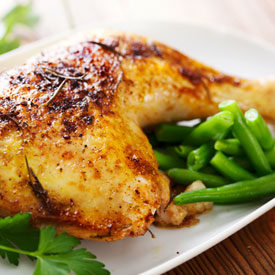
We all need protein to stay healthy and keep our bodies functioning properly. Chicken is the perfect protein to help your body to build and repair cells and it is low in fat and contains essential amino acids.
A single serving of chicken is 3-ounces, which is the size of a deck of cards or about the size of an adult palm. According to the National Chicken Council, a 3-ounce serving of a cooked skinless, boneless breast has just 1 gram of saturated fat and less than 4 grams of total fat, contains 31 grams of protein and is low in sodium. It also is high in B vitamins, which helps with metabolism, immunity and maintaining normal glucose levels. Protein is essential for strong bones and muscles.
An important difference between dark meat and white meat chicken is the fat content. Dark meat is higher in fat and it contains more iron than white meat. Dark meat also stays moister at higher cooking temperatures, which makes it a better choice for grilling over white meat. The highest amount of fat is found in the skin of chicken. Cooking chicken with the skin-on will help hold moisture and flavor. It is probably best to take the skin off for eating to avoid the extra fat that the skin contains.

At the market:
Preventing food-borne illness is a top priority. Here are top tips for getting chicken safely from the market to the dinner table.
- When shopping, pick up fresh chicken last.
- Choose packaged chicken in which the meat appears pink, not gray or yellow. But don’t be concerned if the chicken skin is yellow; either yellow or white is normal.
- Make sure the package is tightly sealed and cold to the touch.
- Check the “sell-by” date; if it has passed, don’t buy it.
- Have fresh chicken bagged separately from other groceries.
- When unpacking groceries, refrigerate chicken until ready to prepare or freeze.
Read Chicken: What To Buy to learn more about shopping for chicken at the market.
Storing:
- Refrigerate fresh chicken in its original package on a low shelf in a cold part of the refrigerator for up to 2 days. Freeze uncooked chicken if it won’t be used within that time.
- For extra protection, place chicken in a plastic bag to separate it from other foods and to prevent it from dripping onto other items in the refrigerator.
- Always use chicken by the “sell-by” date, unless you freeze it.
- Keep frozen chicken as long as nine months to a year.
Preparation and cooking:
- Wash hands thoroughly after handling raw chicken.
- Use separate cutting boards to avoid cross-contamination—one for raw meats and one for fruits and vegetables.
- Defrost chicken in the refrigerator (or in the microwave, if cooking immediately); never defrost on the counter. Chicken may be thawed in cold water. Place chicken in its original wrap or water-tight plastic bag in cold water. Change water often. With this method, it takes about 2 hours to thaw a whole chicken.
- Do not put frozen chicken in the slow cooker. Instead, thaw first and then place in the slow cooker.
- Use a meat thermometer to ensure doneness. Cook boneless chicken breasts to 165° F; bone-in breasts to 170°, thighs and legs to 180° F; ground chicken to 165° F; and whole chicken to 180° F, measured in the thigh.
- To check chicken visually for doneness, pierce chicken with a fork; juices should run clear — not pink — when fork is inserted with ease.
- Marinade in which raw chicken has been soaking should never be used on cooked chicken.
- Don’t leave cooked chicken at room temperature for more than two hours.

Our favorite chicken recipes:
Baked Chicken with Blueberry BBQ Sauce


